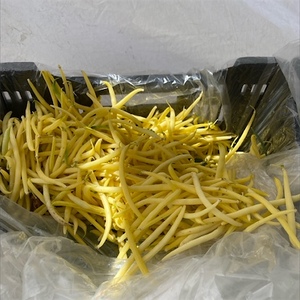


Yellow Baby French Beans
Estimated Inventory, lb : 0
Description/Taste
Baby Yellow French beans are a bean unmatched in flavor and tenderness. They are harvested at lengths no longer than four inches, an age at which the beans are still immature. Their string-less seamed shell is a pale lemon lime color with translucent yellow succulent flesh bearing a handful of tiny and tender yellow seeds. The yellow color of baby Yellow French beans will turn to a pale green hue when cooked. A quick boil followed by an ice bath can help preserve some of their yellow coloring. The young beans can also be utilized in their raw form as a means to showcase their vibrant hue. Overall, the baby Yellow French beans are faintly grassy, crunchy and sweet and will be at best flavor and texture when just lightly cooked. When selecting beans look for pods that are smooth and free of bruises, pods should also be crisp and snap when bent.
Seasons/Availability
Baby Yellow French beans are available in the summer and early fall months.
Current Facts
Baby Yellow French beans botanically are a part of Phaseolus vulgaris and a member of the Fabaceae family along with common beans and peas. Unlike common beans and peas however baby Yellow French beans are specifically bred and cultivated for their pods versus their seeds. Also known as an edible pod bean or green bean type, there are several types of French bean varieties, and they can be found in colors of green, yellow and purple. Whatever colors the bean may be they are known culinarily as a green bean type because they are utilized in their “green” or immature stage. There is little difference, botanically between a French bean and a "common" green bean, they differ only in maturity with the French beans being harvested young when they offer an exceptionally tender bite and sweet flavor that they have become prized for.
Nutritional Value
Baby French Yellow beans contain a large amount of water and offer some of vitamins B, C, A and E as well as manganese, iron and potassium. The beans offer significantly less protein than shell type beans as a result of their immature seeds. For the highest nutritional content beans should be consumed raw or just lightly cooked.
Applications
The baby Yellow French bean can be utilized in its raw form or can be used in cooked applications. Its flavor, texture and nutritional content will be at its peak when cooked just slightly. One of the most popular cooking methods is to blanch the beans by quickly boiling in water then submerging in an ice bath. Lightly cooked or raw beans will compliment pasta, green, and grain salads. Raw beans can be served whole alongside creamy dips as a crudité. Blanched beans can be served as a side dish to accompany roasted poultry, shellfish, and beef stew. Baby Yellow French beans can also be added last minute to risotto, sautés, pasta, and stir-fries. Their texture and flavor pair well with mushrooms, red bell pepper, tomato, onion, citrus, olives, potato, shallots, garlic, arugula, anchovies, bacon, cream based sauces, butter, Dijon mustard, egg, tuna, vinegar, gorgonzola, and feta cheese. Baby Yellow French beans should be stored wrapped in plastic and refrigerated, for best flavor and texture use within three to four days.
Ethnic/Cultural Info
French beans such as the baby Yellow French are an extremely popular vegetable in French cuisine and known there also as Haricot Jaune. They are ubiquitous as a side dish served simply with butter, lemon, and shallots and also appear in renowned French classics such as gratins, salad nicoise, and a la mornay. In West Africa haricot vert are grown extensively in the former French colony of Burkina Faso where since the 1970’s the French beans have been the country’s most profitable non-traditional export crop. Aside from the expatriate population there is very little domestic demand for the French bean in most of Africa. In Burkina Faso they are however enjoyed by the local population, primarily as a result of beans that for one reason or another do not make it to export in time and end up sold at local markets. In Senegal they are sautéed in butter, in Ouagadougou served with fried meat, and in Lac du Bam where the majority of the beans are grown they are combined with millet meal to make a Sahelian risotto.
Geography/History
French beans' ancestors are believed to be native to South and Central America. It was not until the late sixteenth century that green beans were introduced to Europe by the Spanish and Portuguese. Their popularity in France would grow in the nineteenth century where they would become a staple vegetable in the culinary scene. Rather than the larger, more mature green bean that saturated the market place at the time the French favored the beans at their young, petite and tender stage of growth which is what lead to the immature beans being labeled outside of France as "French beans". Originally all varieties of green beans had strings running the length of the pod that needed to be removed until in 1894 the first stringless green bean was developed in New York State by Calvin Keeney. Like most beans baby Yellow French beans prefer warm growing conditions and are not tolerant of frost.
Recipe Ideas
Recipes that include Yellow Baby French Beans. One
| My Carolina Kitchen |
|
Green Bean Salad Dressed with a French Vinaigrette |
| The Kitchn |
|
Miso Potato Salad with Yellow Wax Beans |
| Domestic Divas |
|
Amberjack with Purple Spring Onions and Yellow Haricot Verts |












